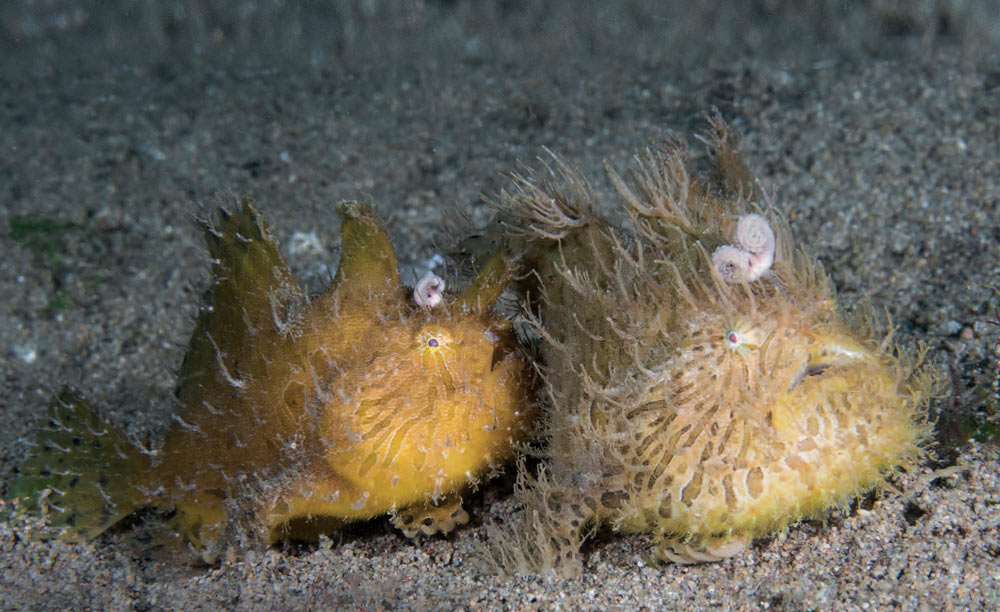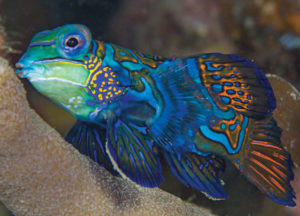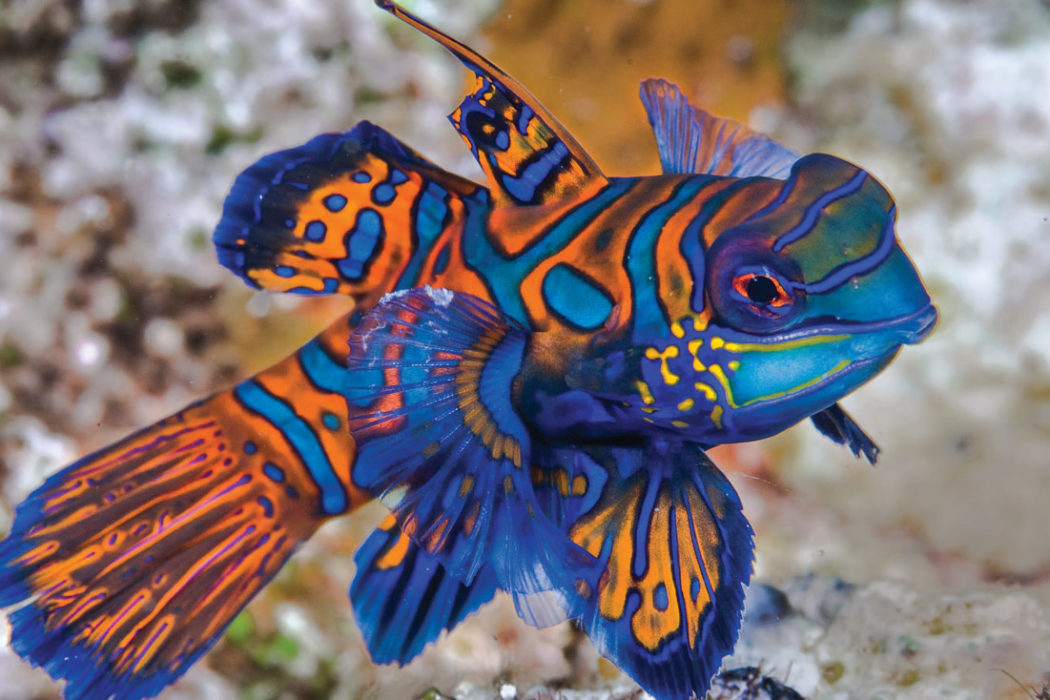THEY OCCUR IN AN ALMOST ENDLESS variety of shapes, colors and patterns. Many are smaller than half-the-size of your little finger. One grows to longer than 40 feet (12.2 m) and weighs as much as 47,000 pounds (21.5 t). They live in almost every permanent body of naturally occurring water on Earth. Some occasionally crawl onto land while others live in the deep waters of the abyss. No one knows exactly how many different kinds there are, but it is generally agreed upon that the total number of species is somewhere north of 28,000 and some specialists suspect a more accurate number to be closer to 40,000.
As you probably figured out, they are fishes and, collectively speaking, they fascinate a lot of divers. In fact, many of us travel thousands of miles every year to enjoy their beauty. While there are many places we can go to see fishes in all their glory, there is little question that the Coral Triangle is among the more popular diving regions in the world. The Coral Triangle is the name given to a marine area in the western Pacific Ocean that includes the waters bounded by Indonesia, Malaysia, the Philippines, Papua New Guinea, Timor Leste and the Solomon Islands. Fish lovers know the area for its more than 2,000 species of reef fishes.
RELATED READ: WHAT MAKES A FISH A FISH?
With so many fishes to see and learn about, it is hard to know where to get started. I have chosen two species that are on the “I want to see” lists of many divers that explore the waters of the Coral Triangle. These species are the hairy frogfish and mandarinfish.

The hairy frogfish and other members of its family are sometimes referred to as anglerfishes in reference to the lure-like appendage connected to the first ray of their dorsal fin is used to attract unsuspecting prey to within striking range in a manner similar to the way a fisherman might use a lure to help catch a fish. Photo by Marty Snyderman.
Hairy Frogfish
Worldwide there are approximately 47 species of bony fishes commonly referred to as frogfishes. These fishes are described in the family Antennariidae. The hairy frogfish, Antennarius striatus, and other members of this family are sometimes referred to as anglerfishes in reference to the lure-like appendage connected to the first ray of their dorsal fin. That ray is used to attract unsuspecting prey to within striking range in a manner similar to the way a fisherman might use a lure to attract a fish. The term anglerfish is also used to refer to a number of deepwater species that are not members of the family Antennariidae.
The species of frogfish encountered by sport divers are typically associated with reef ecosystems, including nearby sand and rubble bottom areas. One widely publicized exception is the sargassumfish, Histrio histrio, a species whose members are usually found in clumps of seaweed that are floating at the surface in the open sea.
RELATED READ: FACES ONLY THEIR MOTHER COULD LOVE: FROGFISHES, TOADFISHES, SCORPIONFISHES AND STONEFISHES
Growing to a maximum length of just under 10 inches (25 cm), the soft skin of the somewhat rounded body of a hairy frogfish is covered with irregularly spaced spines that resemble hairs. Males are usually more intensely colored and have more and longer appendages than females. Also known by the names striated and striped frogfish, the hairy frogfish occurs in tropical and subtropical regions of the Indian Ocean to the central Pacific Ocean, the Atlantic Ocean along the west coast of Africa and from New Jersey to Brazil, including the waters of the Caribbean Sea and in the Gulf of Mexico. Bottom dwellers, hairy frogfish live a solitary lifestyle except when courting and mating.
Upon first glance, frogfishes appear to have faces that only their mothers could love and the hairy frogfish is no exception. But it is equally undeniable that there is something about their appearance that many divers find to be absolutely adorable. Their small and upturned mouths highlight the globular, somewhat humorous looking bodies of frogfishes. Attaining a maximum length of less than seven inches (17.8 cm), the majority of species are relatively small animals. However, there are exceptions such as the Commerson’s frogfish (aka giant frogfish, Antennarius commerson), a species with individuals that routinely grow to more than twice that length.
Masters of camouflage, frogfishes often adapt to bear strong resemblance to their surroundings. As a result, they can be extremely difficult to spot when they are at rest because they often look like nearby sponges, branches of corals or large clumps of encrusting algae. Some species cultivate bits of algae that grow on their bodies.

An amorous male hairy frogfish (left) nuzzles against a slightly larger female (right) in an effort to encourage her to spawn. Photo by Marty Snyderman.
Collectively speaking, the body colors of frogfishes range from white to vivid hues of oranges, yellows, reds and greens to black. The body colors of some are solid. Others mottled or spotted. It is generally believed that the appearance of a given frogfish varies with their surroundings.
The color of hairy frogfish varies greatly. Most are tan to yellow, but the hairy frogfish is also known to be almost solid black to pure white, gray, green and brown. An array of dark body stripes gives rise to the names striated frogfish and striped frogfish.
As is the case with other members of its family, the hairy frogfish would win very few races in swimming contests with other fishes. Their stocky bodies are propelled by their stumpy tails, but they are slow, rather awkward-looking swimmers. Like other frogfishes, hairy frogfish also gain thrust by using jets of water squirted from their mouths. In addition, their pectoral and pelvic fins have evolved into appendages that look like flattened hands. These fins are also used to assist them when they amble across the sea floor and to prop up their bodies while they rest.
RELATED READ: WACKY WORLD OF FISHES
Frogfishes are ambush predators. When actively hunting, the body of one of these clever predators remains almost perfectly still as the fish extends a directable “lure” that is connected to the almost invisible first ray of their dorsal fin. Once the lure is extended, the hunter wiggles it to attract its prey. The worm-like lures of hairy frogfish are relatively large compared to those of many other similarly sized frogfishes and, when wiggled around, the lures are definitely “attention-getters.” A carnivore with a healthy appetite, the hairy frogfish is an opportunistic predator that feeds upon a variety of fishes, crustaceans, mollusks and other animals that come within striking distance.
The moment of attack when a frogfish lunges at and engulfs its prey takes place much too fast for human eyes to follow. When making its move, a frogfish opens its suddenly enormous mouth as wide as it can, as quickly as it can, thus creating a pressure differential in the surrounding water. The “near vacuum” helps the fish suck in the surrounding water and the prey in an incredibly fast act. This feeding technique is known as “gape and suck,” and all the action occurs in less than 1/100th of a second!

A male and female mandarinfish rise up into the water column in close contact with each other when mating. Photo by Marty Snyderman.
Mandarinfish
If there were a beauty contest among fishes, there can be little doubt that the mandarinfish, Synchiropus splendidus, would be among the finalists. With their spectacularly colorful blue, teal, yellow and orange-striped bodies, adorable faces and puckered up mouths, mandarinfish have a stunning appearance. While males, the larger sex, attain a maximum length of only 2.75 inches (7 cm), it is immediately obvious to fish watchers that their eye-popping beauty more than compensates for their diminutive size.
These bottom dwelling jewels inhabit shallow rubble zones and coral reef communities from Ryukyu Islands of Japan to Australia, an area that includes the Coral Triangle. Throughout their range, mandarinfish inhabit shallow protected lagoons and inshore reefs from just below the surface to 60 feet (18 m) in areas where the sea floor is comprised of a mix of living corals, rubble and silt. They are usually present in small groups numbering only a handful of fish with a number of “groups” being distributed over an area that is smaller than a basketball court. During the day and in the dark of night, mandarinfish usually seek cover. But just a few minutes before sunset adults often emerge to feed, court and mate.
RELATED READ: WHY ARE REEF FISH SO COLORFUL?
Mandarinfish are one of approximately 188 members of the dragonet family (Callionymidae). Most dragonets are found in the tropical Indo-Pacific. A relatively broad, depressed head, large spine between the check and gill, and comparatively large fins are noteworthy characteristics of dragonets. The first dorsal fin is equipped with four spines. In males, the dorsal fin is larger and longer with the first spine often being adorned with filamentous extensions.
The elongated, scaleless bodies of mandarinfish and many other of their family members are exceptionally colorful. Mandarinfish and the pictured dragonet, Synchiropus picturatus, are the only two known species of animals that produce blue coloration by making blue pigmented cells. Other animals that look blue create the color by combining aligned layers of crystals in their skin that reflect blue light.
Mandarinfish feed on small worms, copepods, amphipods, mysid shrimps and other small invertebrates. Ever cautious, mandarinfish usually appear to study their food before they eat it. Their relatively large, forward-set eyes help them see in the low light levels of dusk.
Divers are often drawn to mandarinfish because of their courtship displays and spawning behavior in addition to their good looks. During courtship, males pursue females and display by spreading their fins and bumping and rubbing against females. Males also actively confront other males in attempts to drive them away by spreading fins to look as large as possible. When hearts connect, a male and female rise up into the water column in close contact with each other while releasing eggs and sperm. After spawning, the pair settle back down to the sea floor where the male will often quickly seek out another mate.
The bodies of mandarinfish are covered with a number of tiny spines that can inject toxic mucus into any potential predators. Mandarinfish possess two kinds of cells in their skin that secrete mucus. One type produces mucus that coats the body, thus protecting the fish from its surroundings and potential parasites. The other makes a toxin that protects the fish from would be predators. This toxin has a foul odor and taste. These qualities help make up for the lack of protective scales on the bodies of mandarinfish and other dragonets.

Mandarinfish feed on small worms, copepods, amphipods, mysid shrimps and other small invertebrates. Photo by Marty Snyderman.
Watching Mandarinfish
The best way to find mandarinfish is to dive with and pay heed to the insights provided by a knowledgeable guide or an experienced buddy that has seen mandarinfish recently in the exact same area you will be diving. In any case, timing is critical. You want to be in the water, in position and as motionless as you can reasonably be before it gets dark. Don’t be late because all the activity is short-lived and ends with the fish going back into hiding as darkness sets in.
When all goes according to plan, a few minutes before sunset a gathering of what is typically between three and five females make their way to a section of reef that is frequently visited by adult males. To give yourself a good chance to witness spawning, look for adult males that are moving around in the latticework of rubble and branches of living corals near the females. Try to keep an eye on the largest male, as he is the most likely candidate to enjoy success. If he convinces a female to mate, the act takes a matter of seconds as they rise a foot (30 cm) to several feet off the bottom.
There is considerable debate about whether or not a bright light will prevent mandarinfish from mating. Many experienced observers use a rather dim red light instead of a white light because they believe red lights are less disruptive and don’t attract as many worms and crustaceans.






